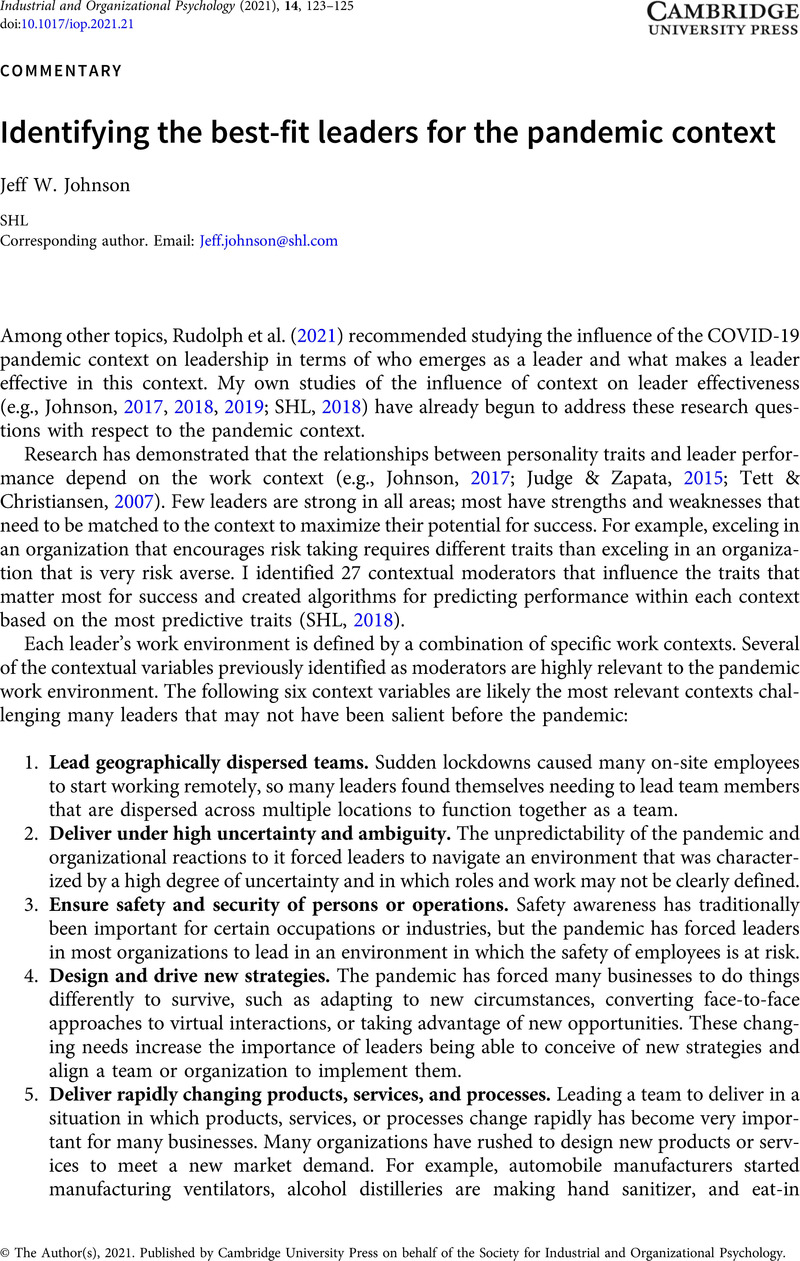No CrossRef data available.
Article contents
Identifying the best-fit leaders for the pandemic context
Published online by Cambridge University Press: 24 May 2021
Abstract
An abstract is not available for this content so a preview has been provided. Please use the Get access link above for information on how to access this content.

- Type
- Commentaries
- Information
- Industrial and Organizational Psychology , Volume 14 , Special Issue 1-2: Special Pandemic Issue , June 2021 , pp. 123 - 125
- Copyright
- © The Author(s), 2021. Published by Cambridge University Press on behalf of the Society for Industrial and Organizational Psychology.
References
Johnson, J. W. (2017, April 27–29). Predicting leader performance from personality: Context is essential. In J. W. Johnson (Chair), Don’t take quotes or personality assessment validities out of context [Symposium]. The Society for Industrial and Organizational Psychology 32nd Annual Conference, Orlando, FL, United States.Google Scholar
Johnson, J. W. (2018, April 27–29). Improving validity and diversity through context-based leader selection. In A. B. Yost (Chair), Work context effects on personality and leadership: Advancing theory and practice [Symposium]. The Society for Industrial and Organizational Psychology 33rd Annual Conference, Chicago, IL, United States.Google Scholar
Johnson, J. W. (2019, April 4–6). Development and validation of SHL’s Leader Edge selection and development tool. In K. Sawyer (Chair), SIOP Select: Distinguished professional contribution and M. Scott Myers [Special event]. The Society for Industrial and Organizational Psychology 34th Annual Conference, National Harbor, MD, United States.Google Scholar
Judge, T. A., & Zapata, C. P. (2015). The person-situation debate revisited: Effect of situation strength and trait activation on the validity of the Big Five personality traits in predicting job performance. Academy of Management Journal, 58, 1149–1179.CrossRefGoogle Scholar
Rudolph, C. W., Allan, B., Clark, M., Hertel, G., Hirshi, A., Kunze, F., Shockley, K., Shoss, M., Sonnentag, S., & Zacher, H. (2021). Pandemics: Implications for research and practice in industrial and organizational psychology. Industrial and Organizational Psychology: Perspectives on Science and Practice, 14(1), 1–35.Google Scholar
Tett, R. P., & Christiansen, N. D. (2007). Personality tests at the crossroads: A response to Morgeson, Campion, Dipboye, Hollenbeck, Murphy, and Schmitt (2007). Personnel Psychology, 60, 967–993.CrossRefGoogle Scholar


